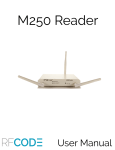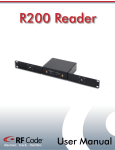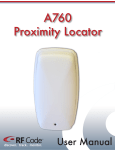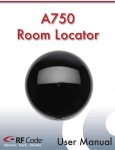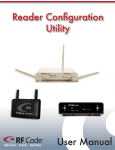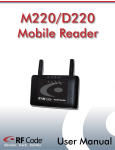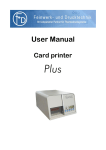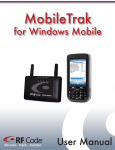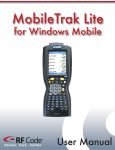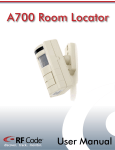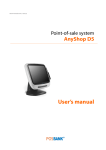Download A740 Rack Locator
Transcript
A740 Rack Locator discover. track. monitor. User Manual e Pa g lly na io nt te In an k Bl Contents Preface Trademarks 5 5 5 6 6 6 A740 Room Locator Overview 7 7 7 7 7 8 9 10 11 11 12 12 14 15 15 19 19 19 23 Copyright Statement FCC Compliance CE Compliance WEEE Compliance Features Content Requirements A740 Operation Notes for A740 Rack Locator and Tag Deployment Hardware Environmental Specifications Software Installation and Configuration Mounting LED Diagnostics Indicators Hardware Driver Installation Utility Software Installation Launching the Rack Locator Utility A740 Configuration Rack Requirements A740 Mounting Procedures Rack Tag Mounting Procedure Warranty & Service Limited Standard Warranty Terms Standard Warranty Limitations Obtaining Service & Support RF Code Customer Support PN01543 REV01 A740 Rack Locator User Manual 24 24 24 24 24 3 e Pa g In t lly na tio en an k Bl Preface Trademarks RF CodeTM and the RF Code logo are trademarks of RF Code, Inc. All other product names are copyright and registered trademarks or trade names of their respective owners. Copyright Statement Copyright © 2010 - 2012 RF Code, Inc. All Rights Reserved. This document, as well as the hardware and firmware described therein, are furnished under license and may only be used or copied in accordance with the terms of such license. The information in these pages is furnished for informational use only, is subject to change without notice, and should not be construed as a commitment by RF Code, Inc. RF Code assumes no responsibility or liability for any errors or inaccuracies that may appear in these pages. RF Code reserves the right to make changes without further notice to any products herein. RF Code makes no warranty, representation or guarantee regarding the suitability of its products for any particular purpose, nor does RF Code assume any liability arising out of the application or use of any product, and specifically disclaims any and all liability, including without limitation consequential or incidental damages. The user of this system is cautioned that any changes or modifications to this system, not expressly approved by RF Code, Inc., could void the warranty. Every effort has been made to supply complete and accurate information. However, RF Code assumes no responsibility for its use, or for any infringements of patents or other rights of third parties, which would result. RF Code, Inc. 9229 Waterford Centre Blvd. Suite 500 Austin, TX 78758 www.rfcode.com PN01543 REV001 A740 Rack Locator User Manual 5 FCC Compliance This equipment has been tested and found to comply with the limits for a Class A digital device, pursuant to Part 15 of the FCC Rules. These limits are designed to provide reasonable protection against harmful interference when the equipment is operated in a commercial environment. This equipment generates, uses, and can radiate radio frequency energy and, if not installed and used in accordance with the instruction manual, may cause harmful interference to radio communications. Operation of this equipment in a residential area is likely to cause harmful interference, in which case the user will be required to correct the interference at his own expense. RF Code is not responsible for any radio or television interference caused by using other than recommended cables and connectors or by unauthorized changes or modifications to this equipment. Unauthorized changes or modifications could void the user’s authority to operate the equipment. This device complies with Part 15 of the FCC rules. Operation is subject to the following two conditions: (1) this device may not cause harmful interference, and (2) this device must accept any interference received, including interference that may cause undesired operation. RF Code, Inc. 9229 Waterford Centre Blvd. Suite 500 Austin, TX 78758 www.rfcode.com Industry Canada Compliance Statement This Class A digital apparatus meets the requirements of the Canadian Interference-Causing Equipment Regulations. Avis de conformité à la réglementation d’Industrie Canada Cet appareil numérique de la classe A respecte toutes les exigences du Règlement sur le matériel brouilleur du Canada. The system is designed to operate with RF Code R104 and/or R114 RFID Tags – whose operating frequency is 433.92 MHz which have been certified or are in the certification process. These R104 and R114 devices comply with part 15 of the FCC rules. Operation is subject to the following two conditions: (1) these devices may not cause harmful interference, and (2) these devices must accept any interference received, including interference that may cause undesired operation. a. FCC ID: P6F2005433 for beacon intervals greater than, or equal to 10 seconds. b. FCC ID: P6F433MHZ for the security tag with beacon intervals less than 10 seconds. CE Compliance This is a Class A product. In a domestic environment, this product may cause radio interference, in which case the user may be required to take adequate measures. This equipment complies with the requirements relating to electromagnetic compatibility, EN 55022 class A, the essential protection requirement of Council Directive 89/336/EEC on the approximation of the laws of the Member States relating to electromagnetic compatibility. WEEE Compliance 6 Do Not Dispose Product with Municipal Waste. Special Collection/Disposal Required. PN01543 REV01 A740 Rack Locator Overview The A740 Rack Locator is an infrared (IR) transmitting device designed specifically for use in IT data centers for both open and closed rack environments. When deployed in concert with IR-enabled tags, the system provides a method of locating tagged assets with rack-level precision. Each Rack Locator transmits an infrared pulse pattern containing a unique 4-digit location code. The intensity of the IR transmissions can be adjusted to achieve complete coverage for open or closed racks with minimal bleed-over to adjacent racks. IR-enabled tags will detect incoming IR signals and periodically transmit the tag’s unique ID and a current IR location code. Tag transmissions are processed in real-time to quickly locate and identify tagged assets with rack-level accuracy. The RF Code product set also includes A750 Room Locators which are used to cover larger areas or rooms such as receiving and staging areas. In a typical installation that utilizes both RF Code Room and Rack Locators, assets can be tracked during their complete life cycle from room to rack locations. The A750 Room Locators have a typical transmission radius of 35 feet or more. The IR transmissions occur within line-of-sight and by reflection effectively flooding the coverage zone with the room location code. It is important that A750 Room Locators are not installed directly in areas where the Rack Locators are being used since they will overpower the A740’s IR transmissions. IR coverage zones are limited by solid structures so Room Locators should be used only when there are physical walls between the Room and Rack Locators. Features • 99% location accuracy and instantaneous tag reporting for 4-post racks with closed doors • 95% location accuracy and instantaneous tag reporting for 4-post open racks • Software-configurable IR emissions control settings • Rack-level location reporting • Field upgradable firmware • Easy mounting configuration requires no dedicated U-space Contents • A740 Rack Locator • Two IR LED strips - Four or five segments each depending on rack configuration • Tie wrap and tie wrap mount • Power supply (100 - 240V input, 12V output) • Rack Locator Utility CD • User manual Rack Locator Utility Requirements • Windows XP, Vista, Windows 7 PN01543 REV001 A740 Rack Locator User Manual 7 A740 Operation A740 Rack Locators and IR-enabled active RFID tags allow for tracking assets with rack level accuracy. Each rack locator transmits an IR signal containing a user-assigned location code. With A740 Rack Locators installed in each rack, the IR-enabled tags will include a specific location code when they transmit their payloads to a reader. As an asset moves from one rack to another its associated tag will transmit the new location code it receives from the newly seen A740. Each A740 Rack Locator can be assigned a unique ID for distinct rack locations. The A740 operating process is illustrated in the image below. The major components consist of the following: 1. A 740 Rack Locator – The A740 Rack Locator continuously transmits an infrared signal containing a Location Code. The A740’s settings such as Location Code, IR Intensity and IR Segments Expected are configured using the Rack Locator Utility. 2. I R Signal – IR-enabled tags will periodically transmit the current Location Code they receive from any A740 Rack Locator. Since IR signals are transmitted by line-of-sight and by reflection, proper installation of rack locators and tags is essential to optimally detect the IR signals. 3. IR-Enabled Asset Tags – Asset tags are attached to assets in the rack to track the movement and current location of those assets. The tags relay an RF beacon to a reader that contains the A740 location identifier seen by the tag. 4. R F Reader – The RF reader receives data transmitted by active RFID tags, this includes the Location Code that is received from the A740 Rack Locators. 5. Rack Locator Utility – The Rack Locator Utility will allow configuration of the A740 Rack Locator. This utility has a simple interface which can be used to update the A740’s Location Code, IR Intensity levels and IR Segments Expected. 8 PN01543 REV01 Deployment Figure 1: A740 Rack Locating Process A740 Rack Locator Data Collection Software IP Network IR LED Strips IR Beam IR Asset Tags RF Sign al Notes for A740 Rack Locator and Tag Deployment Other IR transmission sources can interfere with the A740 Room Locator IR transmissions and IR active RFID tags’ reception. If interference occurs, the IR tag may not be able to successfully decode the IR signal and will cause the tag to report an invalid payload. To avoid any IR interference refer to the following notes: • IR-enabled active tags are NOT designed to work outdoors. Direct sunlight can affect the IR tags ability to properly receive A740 IR transmissions. • Do not cover the IR sensor lens. This will affect the ability of the tag to read A740 signals. • Positioning of tags within a rack can affect the ability of tags to properly receive the A740 IR transmission. Follow all tag mounting guidelines listed in the Rack Tag Mounting Procedure section of this document. • IR active tags will receive transmissions from RF Code A700 and A750 Room Locators. Areas where A740 Rack Locators are in use should not have room locators installed within the same location unless they are separated by non transparent walls. • RF fields of active tags are affected by large metal surfaces. Adhering tags directly onto metal surfaces may result in diminished read range. PN01543 REV01 9 Hardware The A740 Rack Locator consists of a small control box, two flexible Infrared LED light strips and a 12 VDC power supply. The control box’s small profile allows it to be mounted in a rack without taking up any rack U-space. The back of the control box has an adhesive backing allowing it to be mounted on any flat surface on the rack. The dimensions of the control box are 2 inches (5.1cm) by 1.4 inches (3.6 cm) by 0.85 inches (2.2 cm). There are four connectors on the A740 control box. Two connector banks (Bank 1 and Bank 2) are used for connecting the two flexible infrared LED strips, a single power source connector for connecting the 12 VDC power supply and a USB connector used only during configuration. The A740 has an LED indicator on one side used to indicate the control box is functioning properly or to determine any diagnostic issues. Figure 2: A740 Rack Locator Control Box Figure 3: USB Connector 10 PN01543 REV01 Figure 4: Power LED Indicator Hardware LED indicator LED strip bank LED Diagnostics Indicators The A740 control box has a green LED on one side. When the LED is on solid (not blinking) it indicates the A740 control box and IR LED strips are working properly. For diagnostic purposes, the green LED control box will blink if it detects a problem. The number of blinks corresponds to an error number which mean the following: 1 Blink – The IR LED strip is not properly connected to Bank 1 2 Blinks – The IR LED strip is not properly connected to Bank 2 3 Blinks – The IR LED strip connected to Bank 1 has an IR segment missing (IR LED strip may be damaged) 4 Blinks – The IR LED strip connected to Bank 2 has an IR segment missing (IR LED strip may be damaged) 8 Blinks – Power failed or disconnected (No power to the power connector while the USB cable is connected) If multiple problems exist the control box LED will blink a combination of numbers. Environmental Specifications The A740 Rack Locator should only be used under the following environmental conditions: Operating Temperature: 32° to 120° F (0° to 50° C) Storage Temperature: 0° to 175° F (-20° to 80° C) Operating Humidity: 10% to 90% RH non-condensing PN01543 REV01 11 The A740 Rack Locator is configured using the Rack Locator Utility provided on the Rack Locator CD that came with the A740 Rack Locator. A USB Type A to mini-B cable (not provided) is required to connect the A740 Rack Locator hardware to a Windows platform running the Rack Locator Utility. When the A740 is connected only by the USB cable, enough power is supplied to perform all configuration tasks except device calibration. The USB only connection will not provide power to the IR LED strips, so the power supply is required for normal operating mode and for the reporting of Bank status. If the device calibration is performed, the A740 must be also be powered from the power connector. The steps for this process are described below: Hardware Driver Installation Software Installation & Configuration Software Installation and Configuration When first connecting the A740 Room Locator to a PC, the A740 driver will need to be installed. This is performed through the Found New Hardware Wizard that should automatically load when the Rack Locator is connected to the PC. Follow the steps in the wizard to locate the driver software for the A740 Rack Locator. This software is located on the Rack Locator CD that came with the A740 Rack Locator. Select Install from a list or specific location (Advanced) and browse to the root folder of the A740 CD-ROM where the RFCUSBL.inf file is located. Figure 5: A740 Hardware Installation Wizard 12 PN01543 REV01 If your computer does not have the correct driver installed, then it will not be able to recognize the A740 Rack Locator. You will know when this happens if the A740 is not listed in Device Manager or if it is listed but shows an error. In these instances, you need to tell your PC where to find the driver. Be sure that the A740 is powered on. Otherwise, your computer will not see it at all. The name of the drive file that you need to install is RFCUSB.inf and it can be found in any of the following locations: • In the Windows installation directory of the Rack Locator Utility. • On the Rack Locator Utility CD that shipped with your A740 • In the Support area of the RF Code website (http://support.rfcode.com) under the heading Rack Locator Utility (http://support.rfcode.com/customer/portal/articles/716055-utilities-downloads) After obtaining the driver file, install it by performing the following steps: 1. Right-click Computer (or My Computer), left-click Properties, and then click Device Manager (or click Hardware and then Device Manager). 2. Under Ports, right-click the A740 Rack Locator entry with the driver issue and then click Update Driver Software. 3. Click the Browse my computer for driver software option. 4. Point your computer to the location of the driver file (RFCUSB.inf ), click the Next button, and then follow the prompts to complete the installation. PN01543 REV01 13 Driver Installation Driver Installation Issues To install the Rack Locator Utility insert the CD into the CD-ROM drive. The Setup program should automatically start. Click on Install Rack Locator Utility to begin. If the Setup program does not launch use the Windows Explorer to browse to the CD drive and double-click on the setup.exe file. This will launch the install wizard. Follow the prompts to install the utility. Figure 6: Rack Locator Utility Installation Wizard Software Installation & Configuration Utility Software Installation Launching the Rack Locator Utility Once the Rack Locator Utility is installed connect a USB Type A to mini-B cable (not provided) from the A740 control box to the computer on which the utility software is running. To launch the configuration utility, select Start > All Programs > RF Code > Rack Locator Utility > Rack Locator Utility. A740 Configuration In most installations only the A740 Rack Locator’s Location Code setting will need to be updated. In a typical installation each Rack Locator should be set with a unique Location Code. The Location Code is a four digit number from 0001 to 9999. The Rack Locator’s unique Location Code will be used by the management software to determine in which rack an asset is currently installed. It is important to keep a record of the configured Location Codes of the A740 Rack Locators for reference during the installation process. These Location Codes will be used later in the management software configuration. Each A740 has a unique serial number which is 14 alphanumeric characters in length. The serial number can be found on the label attached to the A740 Rack Locator’s power cord and it will also be displayed in the Rack Locator Utility’s main panel. New A740s will have an Intensity setting of 50% by default. This value has been determined to be the most suitable level for most applications. It is highly recommended to use the 50% Intensity level on a trial sample of initial rack installations and verify overall correct asset locations prior to a full installation. Please refer to the instructions below for adjustments of the Intensity settings. The steps for initial configuration of an A740 Rack Locator are described below: 1. E nsure that the A740 Rack Locator is connected to the PC through the USB cable and launch the Rack Locator Utility software. 14 PN01543 REV01 Software Installation 3. The Device Details section will display the Status, Model and Version of the firmware installed on the device, as well as the device’s Serial Number. If the Status reports Disconnected, the device may need to be discovered by selecting the Device > Select device menu item. When the dialog appears click the Discover button. The utility will discover any A740s that are connected to the computer. Select the device from the drop-down list and click the OK button. Software InstalConfiguration lationAndConfiguration and 2. W hen the Rack Locator Utility opens it will prompt a dialog box that will ask if the existing configuration settings should be read from the currently connected A740 device. Choose Yes to have the Utility read and display the current settings configured for the connected A740 Rack Locator. This prompt is set to appear by default each time the Rack Locator Utility software is launched but can be changed by selecting Device > Automatically read settings from device and by choosing Always, Never or Prompt. Alternatively, selecting Device > Read Settings from device will manually read the settings from the device. If the Utility does not show any A740’s connected, unplug the USB cable to the device(s), wait 10 seconds and plug the USB cable back into the device. The operating system may have not properly discovered the USB device being connected. Figure 7: Device Details Figure 8: Device Discovery PN01543 REV01 15 Software Installation & Configuration 4. C hanging Location Code: Under the IR Output Settings section update the Location Code with the appropriate 4 digit Location Code for this device. By default this field is set to 0001. To change the Location Code, type in a 4 digit number and click the Apply Settings button. You can also apply the settings to the device from the menu item Device > Apply settings to device. A confirmation message will be prompted once the settings have been successfully applied to the device. 5. Changing IR Intensity: The Intensity level setting is used to adjust the brightness levels of the IR LED strips. This setting applies to both strips connected to Bank 1 and Bank 2. To change the IR intensity level, move the slider bar to an intensity level between 10% to 100% and click the Apply Settings button. By default the intensity level is set to 50% which is recommended for most applications. Figure 9: IR Intensity Slider Bar 6. Enabling/Disabling IR LED Strips: The Bank 1 and Bank 2 sections in the Rack Locator Utility refer to the IR LED strips connected to the A740 control box. By default both IR LED strip banks are enabled and should remain enabled during typical operation. Rack Locator IR strips will be either 4 or 5 segments in length depending on the Rack Locator type ordered. By default the IR Segments Expected are set to 4, if five segment IR strips are being used, update the IR Segments Expected to 5. Once the IR strips and power supply are connected to the A740, the IR Segments Detected field will report the number of segments detected by the device. If the IR Segments Detected field reports 0 in red, check that the IR LED strip is properly connected. If the Segments Detected field reports a value of OL in red or a value less than expected, the IR LED strip connected to that bank may be damaged and may need to be replaced. Ensure that both Bank 1 and Bank 2 Enabled boxes are checked and click Apply Settings to save settings. Figure 10: IR Segments Disconnected If the 12 VDC power source is not connected to the device, the IR Segments Detected fields will show 0. To determine the actual number of segments present, you must attach the 12 VDC power supply. 7. Upgrade Device Firmware: To upgrade the firmware on the A740 device, select the Device > Upgrade device firmware menu option. A dialog will be prompted displaying a Progress status bar and a Start button. If the Rack Locator has the latest firmware installed, a message will display indicating that an upgrade is not required, otherwise press the Start button to begin the upgrade process. A message indicating the firmware upgrade is complete will be displayed. Click the Done button to close. New firmware versions are delivered in subsequent releases of the Rack Locator Utility. Do not disconnect the device during the upgrade process. Doing so will affect the ability to upgrade the firmware properly. ! 8. Saving Device Configuration File: The Rack Locator Utility allows saving a set of device settings for backup purposes. To save the currently connected Rack Locator’s set of device settings, select the File > Save or File > Save As menu option. This will prompt a file dialog window. Select a location and a name for this device configuration file and click the Save button. The Rack Locator’s configuration file is saved with a .rlc extension. 9. Opening and Applying a Device Configuration File: If a device configuration file for an A740 Rack Locator has been saved, that file can be opened and applied to the original A740 device or to a different Rack Locator. This is performed by selecting the File > Open menu option and then the Apply Settings button. 16 Software Installation Figure 11: Begin Calibration Figure 12: Calibration Complete PN01543 REV01 Software InstalConfiguration lationAndConfiguration and 10. Calibrate Device: The A740 Rack Locator is calibrated during the manufacturing process. Under normal operation the A740 will not need to be calibrated. This operation should be considered an advanced function only used if directed by RF Code Support. To calibrate an A740 attach both IR LED strips to each bank and connect the device to the power supply. From the menu select Device > Calibrate segment counts. A dialog box will appear explaining the calibration process. Press the Calibrate button to begin the device calibration. The status bar will report a Calibration in progress and then a Calibration complete message once successful calibration has finished. Press the Close button to close the dialog box. 17 Mounting Proper mounting of the A740’s IR LED strips and the IR asset tags is important to achieve optimal accuracy of the IR Rack Location solution. Follow all of the requirements and installation guidelines to avoid any decreased accuracy of the A740 Rack Locator system. Rack Requirements • The IR rack solution works for both open and closed four-post racks. For best results, both open and closed racks should have side panels. If side panels are not present, the rack-level accuracy may be affected. Open racks refer to 4-post racks without front doors attached. • Racks must have an adequate area or “lip” to mount the IR light strips on. This mounting surface area must be present on both the entire right and left side of the front of the rack for the IR strip to be adhered to. • The surface that the IR strips will be mounted on should be at a 90 degree angle to the plane of the IT equipment. This requirement is more critical for use with open racks in order to avoid IR bleeding across to other racks. • The IR strips should be able to be mounted directly to the rack frame. The strips can be maneuvered around brackets and holes but excessive deviations in strip placement can affect proper installation. • The IR LED strips can be ordered in four lengths depending on the height of the rack. The proper length strip must be used for the rack they are being installed in. • Rack aisles must be at least 48 inches (4 feet) wide (cold aisle). The installed asset tags need a direct line of sight from at least one of the IR LED strips from either side of the rack. Obstructions in the front of the rack where the IR LED strips and tags are to be mounted can affect the accuracy of the A740 Rack Locator solution. Racks installed with servers that have large protruding bezels or excessive cabling can affect the ability of tags to receive the IR transmissions. Avoid placing any unnecessary items in the front area of the racks that may cause “blind” spots. A740 Mounting Procedure RF Code recommends the following mounting procedure for the A740 Rack Locator device: rior to installation, configure the A740 Rack Locator device using the Rack Locator Utility. An RF Code Reader will P need to be installed within the proper read range of all the racks. rack will have two A740 IR LED strips installed on the right and left side of the front of the rack. Each strip will A run from the top of the rack down to the bottom. Depending on the rack height the IR LED strips can be slightly shorter than the full rack height by up to 3.5 inches. It is recommended that the strip is installed starting from the bottom of the rack and worked toward the top of the rack, leaving the difference in strip length and rack height at the top of the rack. Proper mounting of the IR LED strip inside the rack is important for optimal performance. Once the strip is adhered to the rack surface it will be difficult to make adjustments because the strip adhesive is not intended to be applied more than once. Care should be taken to ensure that the IR LED strip is applied correctly. 1. Identify the area in the front of the rack where the IR strips will be mounted. Check that the IR LED strips will be mounted in a position that ensures that the IR tags are in the plane of the IR coverage area once they are installed in the rack. For example, if the IR tags are mounted where they extend 1 inch on the installed servers then the IR LED strips should be mounted the same 1 inch distance from the servers. For racks with doors, it is important to check that the IR LED strips will not be blocked when the front door is completely closed. 18 PN01543 REV01 Figure 13: LED Strips and A740 Rack Locator Positioning in Rack A740 Rack Locator IR LED Strips 3. C lean the surface of the rack where the IR strip is to be applied. Rack surfaces can contain oil from original manufacturing and can collect dust over time. The IR LED strips have a strong adhesive on the back to adhere the strip to the rack, however dust and especially oil will significantly reduce effectiveness of the adhesive of the strips. The racks are required to be properly cleaned prior to mounting of the strips. Use a clean cloth and a 70 - 100 % isopropyl alcohol solution to clean the rack surface of dust and oil that may be on the rack metal. If using pre-packaged cleaning towelettes, they must not contain any active ingredients other than isopropyl alcohol. Due the flammable nature of isopropyl alcohol, please refer to your companies data center’s policy prior to using larger containers of alcohol in the data center. Allow adequate drying time (5 to 10 minutes) before mounting the IR LED strips. While cleaning, check that the IR LED strip can be consistently applied to the rack without hindering any rack operations such as closing of the door or removing any rack equipment. Once applied, the IR LED strips are not intended to be repositioned. PN01543 REV01 19 Mounting 2. Check that the IR LED strip will fit properly in the rack. For best results it is suggested to initially layout both strips in a rack as a “dry run” prior to actual mounting. Leave the adhesive label on and place the IR LED strip on the rack temporarily with tape and adjust the mounting as needed. Check that the strips are the proper length and that there are no impediments to mounting the IR LED strips in the rack. The IR LED strips can be applied over or around small objects protruding on the racks such as screw heads and small brackets, however excessive bending of the strips should be avoided. Once an installation has been completed in a rack and has the IR LED strips properly mounted, it can be used as a guideline for installations in other identical racks. 4. S tart the mounting of the first strip. The IR LED strips should be mounted where the 1/8”connectors are positioned at the top of the rack. The connectors will connect to a A740 control box mounted within 2 feet from the top of both IR LED strips. Check that there is an open path to allow the IR LED strip cables to feed to the A740 control box. Begin mounting the first strip by starting at the top right side of the rack. Peel the adhesive label backing away from the strip for about 12 inches. Be very careful to only peel the protective label backing leaving the adhesive on the strip. Starting even with the top of the rack begin applying the strip adhesive to the rack (see image below). Apply the peeled strip downwards on to the “lip” of the rack. While applying the IR LED strip to the rack firmly press the strip on to the rack to smooth out the strip. Avoid stretching the IR LED strip as the added tension will affect proper adhesion. Once the strip is fully attached reapply pressure over the full length of the strip to smooth out any remaining bumps to ensure optimal adhesion. Once applied the adhesive on the strip will begin to cure and harden. The adhesive will be fully cured after 72 hours to it’s maximum adhesion level. Figure 14: Application of First LED Strip to Bottom of Rack IR LED Strip Bottom of Rack 5. Apply the remaining portion of the first strip. Continue by peeling the adhesive backing from the IR LED strip in short 1 to 2 foot increments and apply the strip downwards to the bottom of the rack. Be sure to keep the strip aligned straight as it is being mounted. Finish mounting the IR LED strip towards the bottom of the rack. There can be up to 3.5 inches distance left from the end of the IR LED strip to the bottom of the rack remaining. 6. Install the second IR LED strip. Install the IR LED strip to the left side of rack using same steps used in the right side IR LED strip installation mentioned above. 20 8. S ecure the connector to the front of the rack with the tie wrap and tie wrap mount. It is recommended to secure the connector wires to the surface of the rack to hold the IR LED strip cables securely to the rack after they have been installed. This will help prevent the IR LED strips from peeling away due to any gravity strain. The suggested strain relief method with the supplied tie-wrap and tie-wrap mount is shown in the image below. Figure 15: Tie Wrapped Connector Wires 10. M ount the power supply. Connect the power supply connector to the A740 control box power connector and plug the power supply into the appropriate power source. The A740 control box LED will illuminate solid green when successfully powered up. PN01543 REV01 21 Mounting 7. M ount the A740 Control box. Each IR LED strip has a two foot wire connector allowing the A740 control box to be mounted anywhere inside the rack within two feet of the top of the rack. To install the A740 control box, identify a place inside the rack suitable to mount the device where both IR LED strips connectors can reach the A740 control box without having tension on the connector cables. Make sure that both IR banks and USB ports will be accessible when the control box is mounted. Also before installing, take consideration of the best position for the LED indicator to be viewed. Use use a clean cloth and a 70 - 100 % isopropyl alcohol solution to clean the rack surface of dust and oil. Mount the control box in the rack by removing the protective adhesive backing label and apply pressure to mount the box on the rack. Connect the IR LED strips into Bank 1 and Bank 2 of the A740 control box. Rack Tag Mounting Procedure To assure optimal accuracy of the IR Rack Location solution, rack assets should have their IR-enabled active tags mounted using the following guidelines: • R104 tags should be installed with the IR lens side down (label side up) • R104 tags should only be installed horizontally. Installing multiple R104 tags in a vertical fashion can cause excessive IR blocking preventing some tags from properly receiving IR from the strips. • R114 tags should be installed with the lens side facing equipment (label side out), with the tie wrap inserted through the tag hole that is positioned furthest from the IR lens. (i.e.; tags lens positioned towards bottom) • For best results, R104 tags should be mounted where there is a slight bend downward when attached to the asset. • R104 and R114 tags should be installed on an asset where the tag is located at least three inches away from the IR LED strip or side of the rack. This will allow the tag to receive a maximum coverage from multiple IR LEDs. It will also help to prevent the asset tags themselves from blocking a significant amount of any IR LED’s transmission coverage. Figure 16: R104 Rack Tag Mounted with Lens Pointing Downward Figure 17: R114 Rack Tag Mounted with Lens Pointing Downward 22 PN01543 REV01 Warranty & Service Limited Standard Warranty Terms F Code warrants its products to be free from defects in materials and workmanship for a period of 1 year (12 R months) for hardware and software from the date of purchase from RF Code. Its obligation under this warranty is limited to repairing or replacing, at its own sole option, any such defective products. This warranty does not apply to equipment that has been damaged by accident, negligence, or misapplication or has been altered or modified in any way. This warranty applies only to the original purchaser (end-user) and is not transferable. Standard Warranty Limitations xcept as provided herein, the entire liability of RF Code and its suppliers under this limited warranty will be that RF E Code will use reasonable efforts to repair or replace, without charge, all defective Products returned to RF Code by a Customer, as more particularly described in the End User Warranty. Except for the express warranties STATED HEREIN, RF Code makes no other representations or warranties and RF Code hereby disclaims all other warranties, express, implied, statutory, or otherwise, including without limitation, any warranty of merchantability, non-infringement of third party intellectual property rights, fitness for a particular purpose, performance, satisfactory quality, or arising from a course of dealing, usage or trade practice. Obtaining Service & Support in-warranty service, customers have several options. Customers having difficulty with RF Code products should For attempt to solve those problems through RF Code’s Technical Support Problem Escalation Process: irst, contact the RF Code representative or other distributor from whom the RF Code product was purchased for F information on how to obtain local support. Second, contact the RF Code Customer Support via e-mail. Third, contact the RF Code Customer Support via the Support Line. or product returns, the support engineer will give you a return material authorization (RMA) number. No returns F will be accepted without an RMA number. If the warranty expired, there is a charge for repair or replacement per RF Code’s out-of-warranty policy. For full details of the RF Code RMA policy, please review the “RF Code Warranty, RMA, and Extended Warranty Policy” document. RF Code Customer Support F Code Customer Support gives entitled customers and partners the ability to contact RF Code about installation R and usage-related questions as well as make defect inquiries about eligible products that are covered under RF Code warranty agreements. A team of technical specialists can be contacted electronically or via phone. he Support Line is available to provide General Support during normal business hours: Monday through Friday, T 8:00 am to 5:00 pm Central time, excluding national holidays. PN01543 REV01 E-mail: [email protected] Support form: http://www.rfcode.com Voice: 512.439.2244 or toll-free at 866.830.4578 A740 Rack Locator User Manual 23 e Pa g lly na io nt te In an k Bl discover. track. monitor.


























